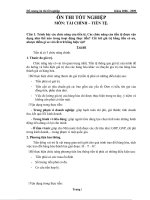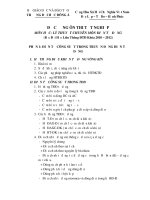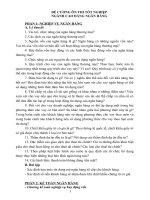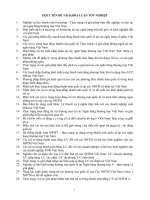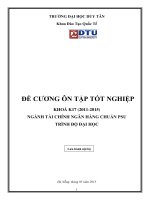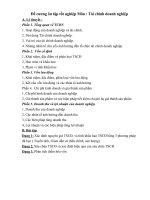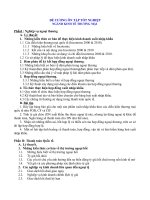Đề cương ôn tập tốt nghiệp ngành tài chính ngân hàng chuẩn PSU trình độ đại học
Bạn đang xem bản rút gọn của tài liệu. Xem và tải ngay bản đầy đủ của tài liệu tại đây (1.01 MB, 51 trang )
TRƯỜNG ĐẠI HỌC DUY TÂN
Khoa Đào Tạo Quốc Tế
ĐỀ CƯƠNG ÔN TẬP TỐT NGHIỆP
KHOÁ K17 (2011-2015)
NGÀNH TÀI CHÍNH NGÂN HÀNG CHUẨN PSU
TRÌNH ĐỘ ĐẠI HỌC
Lưu hành nội bộ
Đà Nẵng, tháng 05 năm 2015
1
TRƯỜNG ĐẠI HỌC DUY TÂN
CỘNG HÒA XÃ HỘI CHỦ NGHĨA VIỆT NAM
KHOA ĐÀO TẠO QUỐC TẾ
Độc lập – Tự do – Hạnh phúc
Tổ PSU
-----------
ĐỀ CƯƠNG ÔN THI TỐT NGHIỆP
KHOÁ K17 (2011-2015)
NGÀNH TÀI CHÍNH NGÂN HÀNG CHUẨN PSU
TRÌNH ĐỘ ĐẠI HỌC
A. MÔN KIẾN THỨC CƠ SỞ NGÀNH (1 TÍN CHỈ)
-
DISCRIPTION
Major contains basic knowkedge of two subjects: Introduction to money,
banking and financial market 1 (PSU FIN 271) and Fundamentals of financial
management 1 (PSU FIN 301).
-
OBJECTIVES
o Introduction to money, banking and financial market is aimed to help
students understand and apply some theories about the relationship between
Six Parts of Financial System and to compare the Parts of Financial System
of Vietnam. Also, they are trained the concepts and roles of Financial
Instrument, Financial Institutions and Financial Markets.
o Fundamentals
of
financial
management
focuses
on the
basic
concepts of financial management to maximize shareholders wealth.
Analyzing fianancial statements in order to understand the financial
situation of a corporations to make decisions. To understand the time
value of money which determines risk and rate of return and valuation of
bonds, and stocks. Establish the capital structure and capital bugeting and
estimate projects. The course has nine lessons to focus on three issues:
Financial Analysis, Valuation of bonds and stocks, Capital Budgeting.
-
TEST FORM: Multiple choice + Exercises
-
TIME: 90 minutes
-
LANGUAGE: English
2
PART I: INTRODUCTION TO MONEY, BANKING AND FINANCIAL MARKETS 1
(PSU-FIN 271)
LESSON 1: AN INTRODUCTION TO MONEY AND FINANCIAL SYSTEM
1.1
THE SIX PARTS OF THE FINANCIAL SYSTEM
We use the first part of the system, money, to pay for our purchases and to store
our wealth. We use the second part, financial instruments, to transfer resources from
savers to investors and to transfer risk to those who are best equipped to bear it. Stocks,
mortgages, and insurance policies are examples of financial instruments. The third part of
our financial system, financial markets, allows us to buy and sell financial instruments
quickly and cheaply. The New York Stock Exchange is an example of a financial market.
Financial institutions, the fourth part of the financial system, provide a myriad of
services, including access to the financial markets and collection of information about
prospective borrowers to ensure they are creditworthy. Banks, securities firms, and
insurance companies are examples of financial institutions. Government regulatory
agencies form the fifth part of the financial system. They are responsible for making sure
that the elements of the financial system—including its instruments, markets, and
institutions—operate in a safe and reliable manner. Finally, central banks, the sixth part
of the system, monitor and stabilize the economy. The Federal Reserve System is the
central bank of the United States.
1.1.1. Money is used to pay for purchases and to store wealth.
1.1.2. Financial instruments are used to transfer resources and risk.
1.1.3. Financial markets allow people to buy and sell financial instruments.
1.1.4. Financial institutions provide access to the financial markets, collect
information, and provide a variety of other services.
1.1.5. Government regulatory agencies aim to make the financial system
operate safely and reliably.
1.1.6. Central banks stabilize the economy.
1.2
THE FIVE CORE PRINCIPLES OF MONEY AND BANKING: are
useful in understanding all six parts of the financial system.
Five core principles will inform our analysis of the financial system and its
interaction with the real economy. Once you have grasped these principles, you will have
3
a better understanding not only of what is happening in the financial world today but of
changes that will undoubtedly occur in the future. The five principles are based on Time,
Risk, Information, Markets, and Stability.
1.2.1 Core Principle 1: Time has value.
1.2.2 Core Principle 2: Risk requires compensation.
1.2.3 Core Principle 3: Information is the basis for decisions.
1.2.4 Core Principle 4: Markets determine prices and allocate resources.
1.2.5 Core Principle 5: Stability improves welfare.
******************************
LESSON 2: MONEY AND THE PAYMENTS SYSTEM
2.1
MONEY AND HOW WE USE IT
Money, in the sense we are talking about, has three characteristics. It is (1) a
means of payment, (2) a unit of account, and (3) a store of value. The first of these
characteristics is the most important. Anything that is used as a means of payment must
be a store of value and thus is very likely to become a unit of account. Let’s see why this
is so.
2.1.1. Means of Payment:
The primary use of money is as a means of payment. Most people insist on
payment in money at the time a good or service is supplied because the alternatives just
don’t work very well.
2.1.2. Unit of Account:
Just as we measure length using feet and inches, we measure value using dollars
and cents. Money is the unit of account that we use to quote prices and record debts. We
could also refer to it as a standard of value.
2.1.3. Store of Value
For money to function as a means of payment, it has to be a store of value, too.
That is, if we are going to use money to pay for goods and services, then it must retain its
4
worth from day to day. Of course, money is not the only store of value. We hold our
wealth in lots of other forms—stocks, bonds, houses, even cars. Many of these are
actually preferable to money as stores of value. Some, like bonds, pay higher interest
rates than money. Others, like stocks, offer the potential for appreciation in nominal
value, which money does not. Still others, like houses, deliver other services over time.
Yet we all hold money because money is liquid.
Liquidity is a measure of the ease with which an asset can be turned into a
means of payment, namely money. For example, a bond is much more liquid than a house
because it is so much easier and cheaper to sell. The more costly it is to convert an asset
into money, the less liquid it is. Because constantly transforming assets into money every
time we wished to make a purchase would be extremely costly, we keep some money
around.
2.2
THE PAYMENTS SYSTEM
Money makes the payments system work. The payments system is the web of
arrangements that allows people to exchange goods and services. Money is the heart of
the payments system. There are three broad categories of payments, all of which use
money at some stage.
The possible methods of payment are:
2.2.1. Commodity Monies
The first means of payment were things with intrinsic value. The first means of
payment were things with intrinsic value.
2.2.2. Fiat Monies
Today, though, we use paper money—high-quality paper, nicely engraved, with
lots of special security features. This type of currency is called fiat money, because its
value comes from government decree, or fiat. Some countries print notes that are durable
and attractive, bearing famous works of art in multiple colors
2.2.3. Checks
Checks are another way of paying for things. Unlike currency, the checks you use
to pay your rent and electric bill are not legal tender. In fact, they aren’t money at all. A
check is just an instruction to the bank to take funds from your account and transfer them
to the person or firm whose name you have written in the ―Pay to the order of‖ line
2.2.4. Electronic Payment
5
The fourth and final method of payment is electronic. We are all familiar with
credit cards and debit cards. A less well known form of payment is electronic funds
transfers.
What is the difference between debit cards and credit cards? A debit card works
the same way as a check in that it provides the bank with instructions to transfer funds
from the cardholder’s account directly to a merchant’s account. There is usually a charge
for this; the processor of the payment takes a fee based on the size of the transaction.
A credit card is a promise by a bank to lend the cardholder money with which
store’s bank account receives payment immediately, but the money that is used for
payment does not belong to the buyer. Instead, the bank that issued the credit card makes
the payment, creating a loan the cardholder must repay. For this reason, credit cards do
not represent money; rather, they represent access to someone else’s moneyto make
purchases.
Electronic funds transfers are movements of funds directly from one account to
another. These transactions are used extensively by banks and are becoming increasingly
popular for individuals as well. For individuals, the most common form is the automated
clearinghouse transaction (ACH), which is generally used for recurring payments such as
paychecks and utility bills.
Banks use electronic transfers to handle transactions among themselves. The most
common method is to send money through a system maintained by the Federal Reserve,
called Fedwire.
Retail businesses, together with their banks, are experimenting with a variety of
new methods of electronic payment. One is the stored-value card, which looks like a
credit or debit card except that it doesn’t bear your name. To use one, you go to the bank
or ATM machine and put the card into an electronic device that transfers funds from your
checking account to your card. Then you take the card to a merchant who has a reader
that is capable of deducting funds from the card and depositing them directly into the
store’s account. The stuff on the card is in fact money, and the system can be set up so
that if you lose your card, its current value can be canceled.
E-money is another new method of payment. It can be used to pay for purchases
on the Internet. You open an account by transferring funds to the issuer of the e-money.
6
Then, when you are shopping online, you instruct the issuer to send your e-money to the
merchant. E-money is really a form of private money.
2.2.5. The Future of Money
•
The future of the three functions of money:
•
Means of payment: disappearing due to ease of electronic transactions.
•
Unit of account: likely to remain.
•
Will always be needed to quote values and prices because it is
efficient.
•
•
2.3
But, will we move to one global unit of account?
Store of value: disappearing due to liquidity of many financial instruments.
MEASURING MONEY
- The monetary aggregates: M1 and M2.
- Liquidity:
7
******************************
LESSON 3: FINANCIAL INSTRUMENT, FINANCIAL MARKETS, AND
FINANCIAL INSTITUTIONS
3.1
FINANCIAL INSTRUMENTS
The written legal obligation of one party to transfer something of value, usually
money, to another party at some future date, under certain conditions.
3.1.1 Functions of Financial Instruments
Three functions:
Financial instruments act as a means of payment (like money). Employees take
stock options as payment for working.
Financial instruments act as stores of value (like money). Financial instruments
generate increases in wealth that are larger than from holding money. Financial
instruments can be used to transfer purchasing power into the future.
Financial instruments allow for the transfer of risk (unlike money). Futures and
insurance contracts allows one person to transfer risk to another.
3.1.2. Classification of financial instruments
Underlying versus Derivative Instruments
Two fundamental classes of financial instruments:
8
•
Underlying instruments are used by savers/lenders to transfer resources
directly to investors/borrowers. This improves the efficient allocation of resources.
Examples: stocks and bonds.
•
Derivative instruments are those where their value and payoffs are
―derived‖ from the behavior of the underlying instruments. The primary use is to shift
risk among investors.
Examples are futures and options.
Examples of Financial Instruments
•
Primarily used as stores of value:
1. Bank loans
2. Bonds
3. Home mortgages
4. Stocks
•
Primarily used to Transfer Risk:
1. Insurance contracts.
2. Futures contracts.
3. Options
3.2
FINANCIAL MARKETS
•
Financial markets are places where financial instruments are bought and sold.
•
These markets are the economy’s central nervous system.
•
These markets enable both firms and individuals to find financing for their
activities.
•
These markets promote economic efficiency:
•
They ensure resources are available to those who put them to their best use.
•
They keep transactions costs low.
3.2.1. The Role of Financial Markets
1.
Liquidity:
2.
Information:
3.
Risk sharing:
3.2.2. The Structure of Financial Markets
3.2.2.1. Primary versus Secondary Markets
9
•
A primary market is one in which a borrower obtains funds from a lender by
selling newly issued securities.
•
Occurs out of the public views.
•
An investment bank determines the price, purchases the securities, and
resells to clients.
This is called underwriting and is usually very profitable
•
Secondary financial markets are those where people can buy and sell existing
securities.
•
Buying a share of IBM stock is not purchased from the company, but from
another investor in a secondary market.
3.2.2.2. Centralized Exchanges, Over-the-Counter Markets (OTC’s), and
Electronic Communication Networks (ECN’s)
•
Centralized exchanges - buyers and sellers meet in a central, physical location.
•
Over-the-counter markets (OTC’s) - decentralized markets where dealers stand
ready to buy and sell securities electronically.
•
Electronic communication networks (ECN’s) - electronic system bringing buyers
and sellers together without the use of a broker or dealer.
3.2.2.3. Debt and Equity versus Derivative Markets
•
Equity markets are the markets for stocks.
•
Derivative markets are the markets where investors trade instruments like futures
and options.
3.3
FINANCIAL INSTITUTIONS
3.3.1. The Role of Financial Institutions
- reduce transaction costs
- reduce the information costs
- give savers ready access to their funds
3.3.2. The Structure of Financial Institutions
Depository institutions take deposits and make loans; they are what most people
think of as banks, whether they are commercial banks, saving banks, credit unions.
and Non-depository institutions include insurance companies, securities firms,
mutual fund companies, hedge funds, finance companies, and pension funds. Each of
10
these serves a very different function from a bank. Some screen and monitor borrowers;
other transfer and reduce risk. Still others are brokers.
1. Depository institutions take deposits and make loans.
2. Insurance companies accept premiums, which they invest, in return for promising
compensation to policy holders under certain events.
3. Pension funds invest individual and company contributions in stocks, bonds, and
real estate in order to provide payments to retired workers.
4. Securities firms include brokers, investment banks, underwriters, and mutual fund
companies. Brokers and investment banks issue stocks and bonds to corporate
customers, trade them, and advise customers. Mutual-fund companies pool the
resources of individuals and companies and invest them in portfolios.
Hedge funds do the same for small groups of wealthy investors.
5. Finance companies raise funds directly in the financial markets in order to make
loans to individuals and firms. Finance companies tend to specialize in particular
types of loans, such as mortgage, automobile, or business equipment.
*****************************
LESSON 4: THE ECONOMY OF FINANCIAL INTERMEDATION
4.1
THE ROLE OF FINANCIAL INTERMEDIARIES
In their role as financial intermediaries, financial institutions perform five
functions:
4.1.2 Pooling the resources of small savers,
4.1.3 Providing safekeeping and accounting services, as well as access to
payments system,
4.1.4 Supplying liquidity by converting savers’ balances directly into a means of
payment whenever needed,
4.1.5 Providing ways to diversify risk, and
4.1.6 Collecting and processing information in ways that reduce information
costs.
4.2 INFORMATION ASYMMETRIES AND INFORMATION COSTS
4.2.1. Adverse selection: Before a transaction, the least creditworthy borrowers
are the ones most likely to apply for funds. This problem is known as adverse
selection
11
4.2.2. Moral hazard: After a transaction, a borrower may not use the borrowed
funds as productively as possible. This problem is known as moral hazard
An obvious way to solve the problem of asymmetric information is to provide
more information. In most industrialized countries, public companies are required
to disclose voluminous amounts of information.
•
Another solution for adverse selection is to make sure lenders are compensated
even if borrowers default.
•
If a loan is insured in some way, then the borrower isn’t a bad credit risk.
Collateral is something of value pledged by a borrower to the lender in the
event of the borrower’s default.
4.3.
•
It is said to back or secure a loan.
•
Ex: Cars, houses
•
Unsecured loans, like credit cards, are loans made without collateral
FINANCIAL INTERMEDIARIES AND INFORMATION COSTS
Much of the information that financial intermediaries collect is used to:
Reduce information costs, and
Minimize the effects of adverse selection and moral hazard.
To do this, intermediaries:
Screen loan applicants,
Monitor borrowers, and
Penalize borrowers by enforcing contracts.
4.3.1. Screening and Certifying to Reduce Adverse Selection
The lender uses the number to identify you to a company that collects and
analyzes credit information, summarizing it for potential lenders in a credit score.
Underwriters screen and certify firms seeking to raise funds directly in the
financial markets
4.3.2. Monitoring to Reduce Moral Hazard
In the financial world, intermediaries insure against this type of moral
hazard by monitoring both the firms that issue bonds and those that issue stocks.
Many hold significant number of shares in individual firms.
They may place a representative on the company’s board of directors.
*****************************
12
LESSON 5: FINANCIAL INDUSTRY STRUCTURE
5.1.
DEPOSITORY INSTITUTIONS
- Functions of Commercial Banks:
- Services Provided:
5.2.
NONDEPOSITORY INSTITUTIONS
5.2.1. Insurance companies
All insurance companies accept premiums from policyholders in exchange
for the promise of compensation if certain events occur.
For the individual policy holder, insurance is a way to transfer risk
Functions of Insurance companies:
In terms of the financial system as a whole, insurance companies specialize
in three of the five functions performed by intermediaries.
•
They pool small premiums and make large investment with them;
•
They diversify risks across a large population; and
They screen and monitor policyholders to mitigate the problem of asymmetric
information.
Two Types of Insurance
Life insurance.
•
Property and casualty insurance
• Life insurance comes in two basic forms.
13
•
Term life insurance provides a payment to the policy holder’s beneficiaries
in the event of the insured’s death at any time during the policy’s term.
•
Generally renewable every year as long as the policyholder is less
than 65 years old.
•
Whole life insurance is a combination of term life insurance and a savings
account.
•
The policyholder pays a fixed premium over his/her lifetime in
return for a fixed benefit when the policyholder dies.
• Car insurance is an example of property and casualty insurance.
•
It is a combination of
•
Property insurance on the car itself, and
•
Casualty insurance on the driver, who is protected against liability
for harm or injury to other people or their property.
•
Holders of property and casualty insurance pay premiums in
exchange for protection during the term of the policy
5.2.2. Pension funds
A pension fund offers people the ability to make premium payments today in
exchange for promised payments under certain future circumstances.
-
They provide an easy way to make sure that a worker saves and has sufficient
resources in old age.
-
They help savers to diversify their risk.
By pooling the savings of many small investors, pension funds spread the risk.
5.2.3. Finance Companies
- Finance companies are in the lending business.
- They raise funds directly in the financial markets by issuing commercial
paper and securities and then use them to make loans to individuals and
corporations.
- They are concerned largely with reducing the transactions and information
costs that are associated with intermediated finance.
- Most finance companies specialize in one of three loan types:
o Consumer loans,
o Business loans, and
14
o What are called sales loans.
o Some also provide commercial and home mortgages.
5.2.4. Securities Firms
The broad class of securities firms includes:
-
Brokerages,
-
Investment banks, and
-
Mutual fund companies.
In one way or another, these are all financial intermediaries.
•
The primary services of brokerage firms are:
•
Accounting (to keep track of customers’ investment balances),
•
Custody services (to make sure valuable records such as stock certificates
are safe), and
•
Access to secondary markets (in which customers can buy and sell financial
instruments).
•
Brokers also provide loans to customers who wish to purchase stock on margin.
•
They provide liquidity, both by offering check-writing privileges with their
investment accounts and by allowing investors to sell assets quickly.
•
Mutual-fund companies offer liquidity services as well.
•
The primary function of mutual funds, however, is to pool the small savings of
individuals in diversified portfolios that are composed of a wide variety of
financial instruments.
•
All securities firms are very much in the business of producing information.
•
•
Information is at the heart of the investment banking business.
Investment banks are the conduits through which firms raise funds in the capital
markets.
•
Through their underwriting services, these investment banks issue new stocks and
a variety of other debt instruments.
The End
REFERNCE RESOURCES:
1. Stephen G. Cecchetti, Kermit L. Schoenholtz, Money, Banking, and Financial
Markets, 3rd Edition, McGraw-Hill, 2011
2. />15
SAMPLE TEST
1. Which of the following statements best describes the Federal Reserve?
A)
The Federal Reserve is shrouded in mystery.
B)
The Federal Reserve is not interested in inflation within the economy.
C)
The Federal Reserve is the central bank of the United States.
D)
The Federal Reserve regulates the stock market.
2. Money:
A)
only consists of paper currency.
B)
is used only to pay for purchases.
C)
was once primarily gold and silver coins but has evolved to electronic funds
transfers.
D)
can only be obtained from a teller at a bank.
3. Financial markets:
A)
include any market in which goods are traded.
B)
have no oversight by the government.
C)
only include large markets like the New York Stock Exchange.
D)
allow us to buy and sell financial instruments easily.
4. The characteristic of money as a store of value implies:
A)
money is acceptable as payment for goods and services.
B)
money allows us to quote prices and record debts.
C)
money will remain valuable from one day to the next.
D)
none of the above.
5. Wealth:
A)
is the value of assets minus liabilities.
B)
serves as a means of payment.
C)
is the same thing as money.
D)
is measured as liabilities plus assets.
6. Which of the following is not a way that consumers and businesses can
make payments:
A)
Stored-value cards.
B)
Checks.
C)
Debit cards.
16
D)
All of the above.
7. Which of the following statements is not true about the future of money?
A)
Money as a means of payment will decline.
B)
We will likely see more money serving as units of account.
C)
With financial instruments evolving, money will be used less as a store of
D)
Money will continue to be necessary.
value.
8. In indirect finance:
A)
lenders loan to borrowers.
B)
an institution borrows from the lender and provides funds to the borrower.
C)
occurs between a borrower and lender, with or without an intermediary.
D)
the borrower is required to have collateral.
9. A loan:
A)
is an asset for both the lender and the borrower.
B)
is an asset for the lender and a liability for the borrower.
C)
is a liability for the lender and an asset for the borrower.
D)
is a liability for both the lender and the borrower.
10. Which of the following is not a characteristic of a financial instrument?
A)
The financial instrument is always issued by a bank.
B)
A financial instrument is a written legal obligation of one party to transfer
something of value, usually money.
C)
The transaction in a financial instrument is specified to take place at a
future date.
D)
A financial instrument specifies certain conditions.
17
PART II: FUNDAMENTALS OF FINANCIAL MANAGEMENT (PSU-FIN 301)
Lesson 1: AN OVERVIEW OF FINANANCIAL MANAGEMENT
1.1
AN OVERVIEW OF FINANCE
1.1.1
Finance verus Economics and Accounting
•
Accounting is the language of business and it reports the results of past economic
activities
•
Finance uses the same or similar concepts and tools but finance looks forward into
the future.
•
The decision making rigors of finance are useless if the results and methods
cannot be communicated clearly!
1.1.2
Finance within an organization
The board of directors is the top governing body, and the chairperson of the board
is generally the highest-ranking individual. The CEO comes next, but note that the
chairperson of the board often serves as the CEO as well.
Below the CEO comes the chief operating officer (COO), who is often also
designated as a firm's president. The COO directs the firm's operations, which include
marketing, manufacturing, sales, and other operating departments. The CFO, who is
generally a senior vice president and the third ranking officer, is in charge of accounting,
financing, credit policy, decisions regarding asset acquisitions, and investor relations,
which involves communications with stockholders and the press.
1.1.3
Finance
Finance as taught in universities is generally divided into three areas: (1) financial
management, (2) capital markets, and (3) investments.
Financial management, also called corporate finance, focuses on decisions
relating to how much and what types of assets to acquire, how to raise the capital needed
to buy assets, and how to run the firm so as to maximize its value.
Capital markets relate to the markets where interest rates, along with stock and
bond prices, are determined. Also studied here are the financial institutions that supply
capital to businesses. Banks, investment banks, stockbrokers, mutual funds, insurance
18
companies, and the like bring together "savers" who have money to invest and
businesses, individuals, and other entities that need capital for various purposes.
Investments relate to decisions concerning stocks and bonds and include a number
of activities: (1) Security analysis deals with finding the proper values of individual
securities. (2) Portfolio theory deals with the best way to structure portfolios, or
"baskets," of stocks and bonds. Rational investors want to hold diversified portfolios in
order to limit risks, so choosing a properly balanced portfolio is an important issue for
any investor. (3) Market analysis deals with the issue of whether stock and bond markets
at any given time are "too high," "too low," or "about right." Behavioral finance, where
investor psychology is examined in an effort to determine if stock prices have been bid
up to unreasonable heights in a speculative bubble or driven down to unreasonable lows
in a fit of irrational pessimism, is a part of market analysis.
1.2
FORMS OF BUSINESS ORGANIZATION
There are four main forms of business organizations:
(1) Sole proprietorships (or private enterprise) is an unincorporated business
owned by one individual. Proprietorships have three important advantages:
- They are easily and inexpensively formed
- They are subject to few government regulations
- They are subject to lower income taxes than are corporation
Proprietorships also have three important limitations:
- Proprietors have unlimited personal liability for the business’s debts
- The life of the business is limited to the life of the individual who created it; and
to bring in new equity, investors require a change in the structure of the business.
- Because of the first two points, proprietorships have difficulty obtaining large
sums of capital; hence, proprietorships are used primarily for small businesses.
(2) A partnership is a legal arrangement between two or more people who decide
to do business together. Partnerships are similar to proprietorships.
(3) A corporation is a legal entity created by a state, and it is separate and distinct
from its owners and managers; Corporations also have limited liability, unlimited lives,
and it is easier to transfer shares of stock in a corporation than one’s interest in an
unincorporated business.
19
- S corporations are a firm which are taxed as if they were partnerships; thus, they
are exempt from the corporate income tax. Besides, S corporation can have no more than
75 stockholders, which limits their use to relatively small, privately owned firms.
- C corporations are larger corporations.
(4) A limited liability company (LLC) and A limited liability partnership
(LLP) are relatively new type of organization that are hybrid between a partnership and a
corporation. Both LLCs and LLPs have limited liability like corporations but are taxed
like partnerships. The main difference between LLCs and LPs is that LLPs are used for
professional firms in the fields of accounting, law, and architecture, while LLCs are used
by other businesses.
1.3
STOCK PRICE AND SHAREHOLDER VALUE
The primary financial goal of management is shareholder wealth maximization,
which translates to maximizing stock price.
Shareholder Wealth Maximization: The primary goal for managers of publicly
owned companies implies that decisions should be made to maximize the long-run value
of the firm's common stock.
Value of any asset is present value of cash flow stream to owners. Firms have a
number of different departments, including marketing, accounting, production, human
resources, and finance. The finance department's principal task is to evaluate proposed
decisions and judge how they will affect the stock price and thus shareholder wealth.
1.4
INTRINSIC VALUE AND STOCK VALUE
Intrinsic Value: An estimate of a stock's "true" value based on accurate risk and
return data. The intrinsic value can be estimated but not measured precisely.
Market Price: The stock value based on perceived but possibly incorrect
information as seen by the marginal investor.
Marginal Investor: An investor whose views determine the actual stock price.
Equilibrium: The situation in which the actual market price equals the intrinsic
value, so investors are indifferent between buying or selling a stock.
*******************************
20
Lesson 2: ANALYSIS OF FINANCIAL STATEMENT
2.1
FINANCIAL STATEMENTS AND REPORTS
A report issued annually by a corporation to its stockholders. It contains basic
financial statements as well as management's analysis of the firm's past operations and
future prospects.
2.1.1
The Balance sheet
The balance sheet is a "snapshot" of a firm's position at a specific point in time.
The left side of the statement shows the assets that the company owns, while the right
side shows the firm's liabilities and stockholders' equity, which are claims against the
firm's assets.
Current assets have a life span of one year or less, meaning they can be converted
easily into cash. Such assets classes include cash and cash equivalents, accounts
receivable and inventory. Cash, the most fundamental of current assets, also includes
non-restricted bank accounts and checks. Cash equivalents are very safe assets that can be
readily converted into cash; U.S. Treasuries are one such example. Accounts receivables
consist of the short-term obligations owed to the company by its clients. Companies often
sell products or services to customers on credit; these obligations are held in the current
assets account until they are paid off by the clients. Lastly, inventory represents the raw
materials, work-in-progress goods and the company’s finished goods.
Long-term assets are assets expected to be used for more than one year; they
include plant and equipment in addition to intellectual property such as patents and
copyrights. Plant and equipment is generally reported net of accumulated depreciation.
Depreciation is calculated and deducted from most of these assets, which represents the
economic cost of the asset over its useful life.
The claims against assets are of two basic types—liabilities (or money the
company owes to others) and stockholders' equity. Liabilities consist of claims that must
be paid off within one year (current liabilities), including accounts payable, accruals
(total of accrued wages and accrued taxes), and notes payable to banks that are due within
one year. Long-term debt includes bonds that mature in more than a year.
21
Stockholders' equity can be thought of in two ways. First, it is the amount that
stockholders paid to the company when they bought shares the company sold to raise
capital, in addition to all of the earnings the company has retained over the years:
Stockholders' equity = Paid -in capital + Retained earnings
The retained earnings are not just the earnings retained in the latest year—they are
the cumulative total of all of the earnings the company has earned during its life.
Stockholders' equity can also be thought of as a residual:
Stockholders' equity = Total assets - Total liabilities
2.1.2
The Income Statement
The income statement is one of the three financial statements - the other two are
the balance sheet and cash flow statement - with which stock investors need to become
familiar. The purpose of this article is to provide the less experienced investor with an
understanding of the components of the income statement in order to simplify investment
analysis and make it easier to apply it to your own investment decisions.
Net Sales (sales or revenue): These all refer to the value of a company's sales of
goods and services to its customers.
Cost of Sales (cost of goods (or products) sold (COGS), and cost of services): For
a manufacturer, cost of sales is the expense incurred for raw materials, labor and
manufacturing overhead used in the production of its goods. While it may be stated
separately, depreciation expense belongs in the cost of sales. For wholesalers and
retailers, the cost of sales is essentially the purchase cost of merchandise used for
resale. For service-related businesses, cost of sales represents the cost of services
rendered or cost of revenues.
Gross Profit (gross income or gross margin): A company's gross profit does
more than simply represent the difference between net sales and the cost of sales. Gross
profit provides the resources to cover all of the company's other expenses. Obviously, the
greater and more stable a company's gross margin, the greater potential there is for
positive bottom line (net income) results.
Selling, General and Administrative Expenses: Often referred to as SG&A, this
account comprises a company's operational expenses. Financial analysts generally
assume that management exercises a great deal of control over this expense category. The
22
trend of SG&A expenses, as a percentage of sales, is watched closely to detect signs,
both positive and negative, of managerial efficiency.
Operating Income: Deducting SG&A from a company's gross profit produces
operating income. This figure represents a company's earnings from its normal operations
before any so-called non-operating income and/or costs such as interest expense, taxes
and special items. Income at the operating level, which is viewed as more reliable, is
often used by financial analysts rather than net income as a measure of profitability.
Interest Expense: This item reflects the costs of a company's borrowings.
Sometimes companies record a net figure here for interest expense and interest income
from invested funds.
Pretax Income: Another carefully watched indicator of profitability, earnings
garnered before the income tax expense is an important step in the income statement.
Numerous and diverse techniques are available to companies to avoid and/or minimize
taxes that affect their reported income. Because these actions are not part of a company's
business operations, analysts may choose to use pretax income as a more accurate
measure of corporate profitability.
Income Taxes: As stated, the income tax amount has not actually been paid - it is
an estimate, or an account that has been created to cover what a company expects to pay.
Special Items or Extraordinary Expenses: A variety of events can occasion charges
against income. They are commonly identified as restructuring charges, unusual or
nonrecurring items and discontinued operations. These write-offs are supposed to be onetime events. Investors need to take these special items into account when making interannual profit comparisons because they can distort evaluations.
Net Income (net profit or net earnings): This is the bottom line, which is the most
commonly used indicator of a company's profitability. Of course, if expenses exceed
income, this account caption will read as a net loss. After the payment
of preferred dividends, if any, net income becomes part of a company's equity position
as retained earnings. Supplemental data is also presented for net income on the basis
of shares outstanding (basic) and the potential conversion of stock options, warrants etc.
2.1.3
Statement of Cash Flows
Statement of Cash Flows is report that shows how things that affect the balance
sheet and income statement affect the firm's cash flows.
23
Three categories
– Operating activities
– Investing activities
– Financing activities
2.2
RATIO ANALYSIS
2.2.1
Liquidity ratios
Liquidity Ratios give us an idea of the firm's ability to pay off debts that are
maturing within a year.
2.2.1.1. Current ratio
The primary liquidity ratio is the current ratio, which is calculated by dividing
current assets by current liabilities:
Current ratio
Current assets
Current liabilities
Current assets include cash, marketable securities, accounts receivable, and
inventories.
If a company is having financial difficulty, it typically begins to pay its accounts
payable more slowly and to borrow more from its bank, both of which increase current
liabilities. If current liabilities are rising faster than current assets, the current ratio will
fall; and this is a sign of possible trouble.
2.2..1.2 Quick or Acid Test, Ratio
The quick, or acid test, ratio is calculated by deducting inventories from current
assets and then dividing the remainder by current liabilities:
Quick ratio
(Current assets Inventories)
Current liabilities
Inventories are typically the least liquid of a firm’s current assets; and if sales slow
down, they might not be converted to cash as quickly as expected. Also, inventories are
the assets on which losses are most likely to occur in the event of liquidation. Therefore,
the quick ratio, which measures the firm’s ability to pay off short-term obligations
without relying on the sale of inventories, is important.
2.2.2
Asset management ratios
Asset management ratios give us an idea of how efficiently the firm is using its
assets.
24
2.2.2.1
Inventory Turnover Ratio
―Turnover ratios‖ divide sales by some asset: Sales/Various assets. As the name
implies, these ratios show how many times the particular asset is ―turned over‖ during the
year. Here is the inventory turnover ratio:
Inventory Turnover = Sales/Inventories
This ratio is regarded as a test of efficiency and indicates the rapiditity with which
the company is able to move its merchandise.
2.2.2.2 Days Sales Outstanding
Accounts receivable are evaluated by the days sales outstanding (DSO) ratio, also
called the average collection period (ACP). It is calculated by dividing accounts
receivable by the average daily sales to find how many days’ sales are tied up in
receivables. Thus, the DSO represents the average length of time the firm must wait after
making a sale before receiving cash.
DSO = Receivables/Avg. sales per day = Receivables/(Annual sales/365)
2.2.2.3 Fixed Assets Turnover Ratio
The fixed assets turnover ratio, which is the ratio of sales to net fixed assets,
measures how effectively the firm uses its plant and equipment:
Fixed Assets Turnover = Sales/Average fixed assets
Potential problems may arise when interpreting the fixed assets turnover ratio.
Recall that fixed assets are shown on the balance sheet at their historical costs less
depreciation. Inflation has caused the value of many assets that were purchased in the
past to be seriously understated. Therefore, if we compare an old firm whose fixed assets
have been depreciated with a new company with similar operations that acquired its fixed
assets only recently, the old firm will probably have the higher fixed assets turnover ratio.
However, this would be more reflective of the age of the assets than of inefficiency on
the part of the new firm. The accounting profession is trying to develop procedures for
making financial statements reflect current values rather than historical values, which
would help us make better comparisons. However, at the moment, the problem still
exists; so financial analysts must recognize this problem and deal with it judgmentally.
2.2.2.4 Total Assets Turnover Ratio
The total assets turnover ratio measures the turnover of all of the firm’s assets; and
it is calculated by dividing sales by total assets:
25

